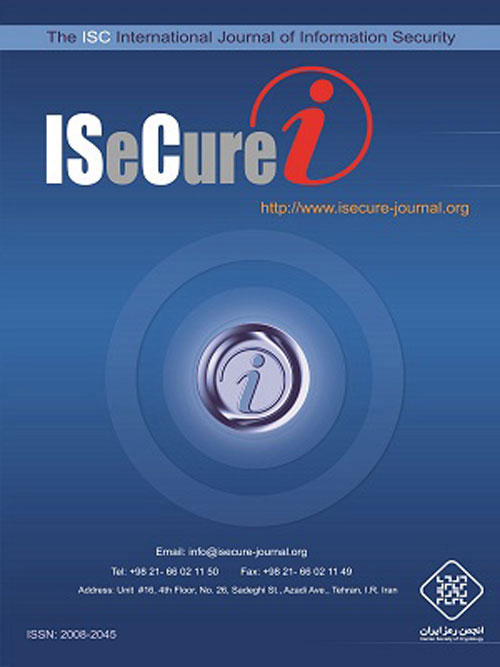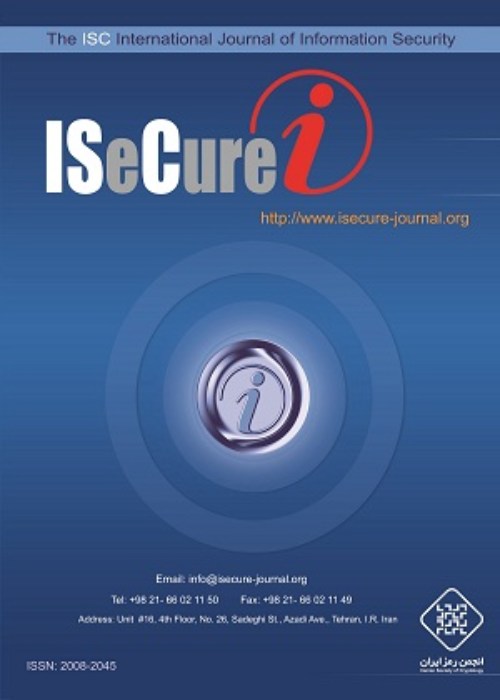فهرست مطالب

International Journal of Information Security
Volume:12 Issue: 2, Jul 2020
- تاریخ انتشار: 1399/05/09
- تعداد عناوین: 6
-
-
Pages 55-68Authenticated encryption schemes are important cryptographic primitives that received extensive attention recently. They can provide both confidentiality and authenticity services, simultaneously. Correlation power analysis (CPA) can be a thread for authenticated ciphers, similar to the any physical implementation of any other cryptographic scheme. In this paper, a three-step CPA attack against COLM, one of the winners of CAESAR, is presented to indicate its vulnerability. To validate this attack, COLM is implemented on the FPGA of the SAKURA-G board. A successful CPA attack with zero value power model is mounted by measuring and collecting 1,800 power traces. In addition, a protected hardware architecture for COLM is proposed to make this design secure against first-order CPA attacks, where a domain-oriented masking (DOM) scheme with two-input/output shares is used to protect it. To verify these countermeasures, we mount first and second-order CPA attacks and a non-specified t-test on the protected COLM. Keywords: Authenticated Cipher, COLM, CPA, DOM, Masking.Keywords: Authenticated Cipher, COLM, CPA, DOM, masking
-
Pages 69-77In cloud computing, multiple users can share the same physical machine that can potentially leak secret information, in particular when the memory de-duplication is enabled. Flush+Reload attack is a cache-based attack that makes use of resource sharing. T-table implementation of AES is commonly used in the crypto libraries like OpenSSL. Several Flush+Reload attacks on T-table implementation of AES have been proposed in the literature which requires a notable number of encryptions. In this paper, we present a technique to enhance the Flush+Reload attack on AES in the ciphertext-only scenario by significantly reducing the number of needed encryptions in both native and cross-VM setups. In this paper, we focus on finding the wrong key candidates and keep the right key by considering only the cache miss event. Our attack is faster than previous Flush+Reload attacks. In particular, our method can speed-up the Flush+Reload attack in cross-VM environment significantly. To verify the theoretical model, we implemented the proposed attack.Keywords: Memory de-duplication, Flush+Reload attack, AES, T-table implementation
-
Pages 79-87A non-interactive (t,n)-publicly veri able secret sharing scheme (non-interactive (t,n)-PVSS scheme) is a (t,n)-secret sharing scheme in which anyone, not only the participants of the scheme, can verify the correctness of the produced shares without interacting with the dealer and participants. The (t,n)-PVSS schemes have found a lot of applications in cryptography because they are suitable for real-life scenarios in which an external verifier is required to check the correctness of the produced shares without interacting with the dealer and participants. In this paper, we propose a non-interactive (t,n)-PVSS scheme using the non-homogeneous linear recursions (NHLRs), and prove its security with a formal method. We compare the computational complexity of our scheme with that of Schoenmakers's scheme and show that our non-interactive (t,n)-PVSS scheme runs faster than Schoenmakers's scheme when n > 5 and n> t >(2n+9)/n. The communicational complexity of our scheme is almost equal to that of Schoenmakers's scheme.Keywords: Cryptography, Secret Sharing, Verifiable Secret sharing, Publicly verifiable secret sharing, Threshold access structures, Non-homogeneous linear recursions
-
Pages 89-99Machine to machine (M2M) communication, which is also known as machine type communication (MTC), is one of the most fascinating parts of mobile communication technology and also an important practical application of the Internet of Things. The main objective of this type of communication, is handling massive heterogeneous devices with low network overheads and high security guarantees. Hence, various protocols and schemes were proposed to achieve security requirements in M2M communication and reduce computational and communication costs. In this paper, we propose the group-based secure lightweight handover authentication (GSLHA) protocol for M2M communication in LTE and future 5G networks. The proposed protocol mutually authenticates a group of MTC devices (MTCDs) and a new eNodeB (eNB) when these simultaneously enter the coverage of the eNB with considering all the cellular network requirements. The security analysis and formal verification by using the AVISPA tool show that the protocol has been able to achieve all the security goals and overcome various attacks. In addition, the comparative performance analysis of the handover authentication protocols shows that the proposed protocol has the best computational and communication overheads.Keywords: IoT, Network Security, M2M communication, Group-based handover authentication, AVISPA
-
Pages 101-115Distributed Denial of Service (DDoS) is a common attack in recent years that can deplete the bandwidth of victim nodes by flooding packets. Based on the type and quantity of traffic used for the attack and the exploited vulnerability of the target, DDoS attacks are grouped into three categories as Volumetric attacks, Protocol attacks and Application attacks. The volumetric attack, which the proposed method attempts to detect it, is the most common type of DDoS attacks. The aim of this paper is to reduce the delay of real-time detection of DDoS attacks utilizing hybrid structures based on data stream algorithms. The proposed data structure (BHM ) improves the data storing mechanism presented in STONE method and consequently reduces the detection time. STONE characterizes regular network traffic of a service by aggregating it into common prefixes of IP addresses, and detecting attacks when the aggregated traffic deviates from the regular one. In BHM, history refers to the output traffic information obtained from each monitoring period to form a reference profile. The reference profile is created by employing historical information and only includes normal traffic information. The delay of DDoS attack detection increases in STONE due to long-time intervals between each monitoring period. The proposed method (F-STONE) has been compared to STONE based on attack detection time, Expected Profile Update Time (EPUT), and rate of attack detection. The evaluation results indicated significant improvements in terms of the EPUT, acceleration of attack detection and reduction of false positive rate.Keywords: DDoS detection, Real time detection, Data stream algorithm, Binary-mapped Historical-memory Management, Anomaly Detection, Expected Profile Update Time
-
Pages 117-128
Electronic health record (EHR) system facilitates integrating patients' medical information and improves service productivity. However, user access to patient data in a privacy-preserving manner is still challenging problem. Many studies concerned with security and privacy in EHR systems. Rezaeibagha and Mu [1] have proposed a hybrid architecture for privacy-preserving accessing patient records in a cloud system. In their scheme, encrypted EHRs are stored in multiple clouds to provide scalability and privacy. In addition, they considered a role-based access control (RBAC) such that for any user, an EHR access policy must be determined. They also encrypt the EHRs by the public keys of all users. So, for a large amount of EHRs, this scheme is not efficient. Furthermore, using RBAC for access policy makes the policy changing difficult. In their scheme, users cannot search on encrypted EHRs based on diseases and some physicians must participate in the data retrieval by a requester physician. In this paper, we address these problems by considering a ciphertext-policy attribute-based encryption (CP-ABE) which is conceptually closer to the traditional access control methods such as RBAC. Our secure scheme can retrieve encrypted EHR based on a specific disease. Furthermore, the proposed scheme guarantees the user access control and the anonymity of the user or data owner during data retrieval. Moreover, our scheme is resistant against collusion between unauthorized retrievers to access the data. The analysis shows that our scheme is secure and efficient for cloud-based EHRs.
Keywords: Access Control, Electronic health record, Attribute-Based Encryption, EHR, Cloud Storage


